- Home
- Hunter S. Thompson
The Curse of Lono Page 2
The Curse of Lono Read online
Page 2
There is only one way to get your arm dyed blue on a 747 flying at 38,000 feet over the Pacific. But the truth is so rare and unlikely that not even the most frequent air travelers have ever had to confront it -- and it is usually not a thing that the few who understand want to talk about.
The powerful disinfectant that most airlines use in their toilet-flushing facilities is a chemical compound known as Dejerm, which is colored a very vivid blue. The only other time I ever saw a man come out of an airplane bathroom with a blue arm was on a long flight from London to Zaire, en route to the Ali-Foreman fight. A British news correspondent from Reuters had gone into the bathroom and somehow managed to drop his only key to the Reuters telex machine in Kinshasa down the aluminum bowl. He emerged about 30 minutes later, and he had a whole row to himself the rest of the way to Zaire.
It was almost midnight when I emerged from Lavatory 1B and went back to my seat to gather up my research material. The overhead lights were out and the other passengers were sleeping. It was time to go upstairs to the dome lounge and get some work done. The Honolulu Marathon would be only one part of the story. The rest would have to deal with Hawaii itself, and that was something I'd never had any reason to even think about. I had a quart of Wild Turkey in my satchel, and I knew there was plenty of ice upstairs in the dome bar, which is usually empty at night.
But not this time. When I got to the top of the spiral staircase I saw my fellow traveler, Mr. Ackerman, sleeping peacefully on one of the couches near the bar. He woke up as I passed by on my way to a table in the rear, and I thought I saw a flicker of recognition in the weary smile on his face.
I nodded casually as I passed. "I hope you found it," I said.
He looked up at me. "Yeah," he said. "Of course."
By this time I was ten feet behind him and spreading my research materials out on the big card table. Whatever it was, I didn't want to know about it. He had his problems and I had mine. I had hoped to have the dome to myself for these hours, to be alone, but Mr. Ackerman was obviously settled in for the night. It was the only place on the plane where his presence wouldn't cause trouble. He would be with me for a while, so I figured we might as well get along.
There was a strong odor of disinfectant in the air. The whole dome smelled like the basement of a bad hospital. I opened all the air vents above my seat, then spread my research out on the table. I tried to remember if the British correspondent had suffered any pain or injury from his experience, but all that came to mind was that he wore heavy long-sleeved shirts the whole time he was in Zaire. No loss of flesh, no poison oil in the nervous system, but three weeks in the heat of the Congo had caused an awful fungus to come alive on his arm, and when I saw him in London two months later his hand was still noticeably blue.
I walked up to the bar and got some ice for my drink. On the way back to my desk I asked him, "How's your arm?"
"Blue," he replied. "And it itches."
I nodded. "That's powerful stuff. You should probably check with a doctor when you get to Honolulu."
He eased up in his seat and looked back at me. "Aren't you a doctor?" he asked.
"What?"
He smiled and lit a cigarette. "It's on your luggage tags," he said. "It says you're a doctor."
I laughed, and looked down at my satchel. Sure enough, the Red Carpet Club baggage tag said, "Dr. H. S. Thompson."
"Jesus," I said. "You're right. I am a doctor."
He shrugged.
"Okay," I said finally, "let's get that weird shit off your arm." I stood up and motioned him to follow me into the tiny "crew only" bathroom behind the flight deck. We spent the next 20 minutes scrubbing his arm with soap-soaked paper towels, then I rubbed it down with a jar of cold cream from my shaving kit.
A nasty red rash like poison ivy had broken out all over his arm, thousands of filthy little bubbles. . . I went back to my bag for a tube of Desenex, to kill the itching. There was no way to get rid of the blue dye.
"What?" he said. "It won't wash off?"
"No," I told him. "Maybe two weeks in saltwater can dull it out. Get out in the surf, hang around on the beach."
He looked confused. "The beach?"
"Yeah," I said. "Just go out there and do it. Tell them whatever you have to, call it a birthmark. . ."
He nodded. "Yeah. That's good, Doc -- what blue arm? Right?"
"Right," I said. "Never apologize, never explain. Just act normal and bleach the bugger out. You'll be famous on Waikiki Beach."
He laughed. "Thanks, Doc. Maybe I can do you a favor sometime -- what brings you to Hawaii?"
"Business," I said. "I'm covering the Honolulu Marathon for a medical journal."
He nodded and sat down, stretching his blue arm out on the couch to give it some air. "Well," he said finally, "whatever you say, Doc." He grinned mischievously. "A medical journal. Jesus, that's good."
"What?"
He nodded thoughtfully and put his feet up on the table in front of him, then turned to smile at me. "I was just wondering how I might return the favor," he said. "You staying long in the islands?"
"Not in Honolulu," I said. "Just until after the Marathon on Saturday, then we're going over to a place called Kona."
"Kona?"
"Yeah," I said, leaning back and opening one of my books, a nineteenth-century volume titled The Journal of William Ellis.
He leaned back on the cushions and closed his eyes again. "It's a nice place," he said. "You'll like it."
"Well," I said, "that's good to know. I've already paid for it."
"Paid?"
"Yeah. I rented two houses on the beach."
He looked up. "You paid in advance?"
I nodded. "That was the only way I could get anything," I said. "The whole place is booked up."
"What?" He jerked up in his seat and stared back at me. "Booked up? What the hell are you renting -- the Kona Village?"
I shook my head. "No," I said. "It's some kind of estate with two big houses and a pool, pretty far out of town."
"Where?" he asked.
There was something wrong with the tone of his voice, but I tried to ignore it. Whatever he was about to tell me, I felt, was something I didn't want to hear. "Some friends found it for me," I said quickly. "It's right on the beach. Totally private. We have to get a lot of work done."
Now he was definitely looking troubled. "Who'd you rent it from?" he asked. And then he mentioned the name of the real estate agent that I had, in fact, rented it from. The look on my face must have alarmed him, because he instantly changed the subject.
"Why Kona?" he asked. "You want to catch fish?"
I shrugged. "Not especially. But I want to get out on the water, do some diving. A friend of mine has a boat over there."
"Oh? Who's that?"
"A guy from Honolulu," I said. "Gene Skinner."
He nodded. "Yeah," he said. "Sure, I know Gene -- The Blue Boar." He leaned up from the cushions and turned to look back at me, no longer half asleep. "He's a friend of yours?"
I nodded, surprised by the smile on his face. It was a smile I had seen before, but for a moment I couldn't place it.
Ackerman was still looking at me, an odd new light in his eyes. "Haven't seen him in a while," he said. "He's back in Hawaii?"
Whoops, I thought. Something wrong here. I recognized that smile now; I had seen it on the faces of other men, in other countries, at the mention of Skinner's name.
"Who?" I said, standing up to get some more ice.
"Skinner," he said.
"Back from where?" I wanted no part of Skinner's ancient feuds.
He seemed to understand. "You know anybody else in Kona?" he asked. "Besides Skinner?"
"Yeah," I said. "I know some people in the whiskey business. I know some real estate agents."
He nodded thoughtfully, staring down at the long fingers of his freshly-blued hand as if he'd just noticed something odd about it. I recognized t
he professional pause of a man long accustomed to the sound of his own brain working. I could almost hear it -- the high-speed memory-scan of a very personal computer that would sooner or later come up with whatever fact, link, or long-forgotten detail he was waiting for.
He closed his eyes again. "The big island is different from the others," he said. "Especially that mess in Honolulu. It's like going back in time. Nobody hassles you, plenty of space to move around. It's probably the only place in the islands where the people have any sense of the old Hawaiian culture."
"Wonderful," I said. "We'll be there next week. All we have to do in Honolulu is cover the Marathon, then hide out in Kona for a while and lash the story together."
"Right," he said. "Call me when you get settled in. I can take you around to some of the places where the old magic still lives." He smiled thoughtfully. "Yeah, we can go down to South Point, the City of Refuge, spend some time with the ghost of Captain Cook. Hell, we might even do some diving -- if the weather's right."
I put my book down and we talked for a while. It was the first time anybody had ever told me anything interesting about Hawaii -- the native legends, old wars, missionaries, the strange and terrible fate of Captain Cook.
"This City of Refuge looks interesting," I said. "You don't find many cultures with a sense of sanctuary that powerful."
"Yeah," he said, "but you had to get there first, and you had to be faster than whoever was chasing you."
City of Refuge at Honaunau
Adjoining the Hare o Keave to the southward, we found a Pahu tabu (sacred enclosure) of considerable extent, and were informed by our guide that it was one of the puhonuas of Hawaii, of which we had so often heard the chiefs and others speak. There are only two on the island; the one which we were then examining, and another at Waipio, on the north-east part of the island, in the district of Kohala.
These puhonuas were the Hawaiian cities of refuge, and afforded an inviolable sanctuary to the guilty fugitive who, when flying from the avenging spear, was so favoured as to enter their precincts.
This had several wide entrances, some on the side next the sea, the others facing the mountains. Hither the manslayer, the man who had broken a tabu, or failed in the observance of its rigid requirements, the thief, and even the murderer, fled from his incensed pursuers, and was secure.
To whomsoever he belonged, and from whatever part he came, he was equally certain of admittance, though liable to be pursued even to the gates of the enclosure.
Happily for him, those gates were perpetually open; and as soon as the fugitive had entered, he repaired to the presence of the idol, and made a short ejaculatory address, expressive of his obligations to him in reaching the place with security.
The priests, and their adherents, would immediately put to death any one who should have the temerity to follow or molest those who were once within the pale of the pahu tabu; and, as they expressed it, under the shade or protection of the spirit of Keave, the tutelar deity of the place.
We could not learn the length of time it was necessary for them to remain in the puhonua; but it did not appear to be more than two or three days. After that, they either attached themselves to the service of the priests, or returned to their homes.
The puhonua at Honaunau is capacious, capable of containing a vast multitude of people. In time of war, the females, children, and old people of the neighboring districts, were generally left within it, while the men went to battle. Here they awaited in safety the issue of the conflict, and were secure against surprise and destruction, in the event of a defeat.
The Journal of William Ellis
(Circa 1850)
He chuckled. "It was a sporting proposition, for sure."
"But once you got there," I said, "you were absolutely protected -- right?"
"Absolutely," he said. "Not even the gods could touch you, once you got through the gate."
"Wonderful," I said. "I might need a place like that."
"Yeah," he said. "Me too. That's why I live where I do."
"Where?"
He smiled. "On a clear day I can look down the mountain and see the City of Refuge from my front porch. It gives me a great sense of comfort."
I had a feeling that he was telling the truth. Whatever kind of life Ackerman lived seemed to require a built-in fall-back position. You don't find many investment counselers from Hawaii or anywhere else who can drop anything so important down the tube in a 747 bathroom that they will get their arms dyed bright blue to retrieve it.
We were alone in the dome, 38,000 feet above the Pacific with at least another two hours to go. We would be in Honolulu sometime around sunrise. Over the top of my book I could see him half-asleep but constantly scratching his arm. His eyes were closed, but the fingers of his clean hand were wide awake and his spastic movements were beginning to get on my nerves.
The stewardess came up to have a look at us, but the sight of Ackerman's arm made her face quiver and she quickly went back down the stairs. We had a small icebox full of Miller High Life and a whole selection of mini-bottles in the liquor drawer, so there was no need to do anything but keep a wary eye on Ackerman.
Finally he seemed to be asleep. The dome was dark, except for the small glow of table lights, and I settled back on the couch to ponder my research material.
The main impression I recall from what I read in those hours is that the Hawaiian Islands had no written history at all beyond the past two hundred years, when the first missionaries and sea captains began trying to interpret a chronology of some kind by listening to tales told by natives. Nobody even knew where the islands themselves had come from, much less the people.
On the gray afternoon of January 16, 1779, Captain James Cook, the greatest explorer of his age, sailed the two ships of his Third Pacific Expedition into the tiny rock-walled shelter of Kealakekua Bay on the west coast of a previously uncharted mid-Pacific island called "Owhyhee" by the natives, and found his place in history as the first white man to officially "discover" the Hawaiian Islands.
The bay inside the channel was shrouded in fog and surrounded by a wall of sheer cliffs, 500 feet high. It looked more like a tomb than a harbor, and -- despite the desperate condition of his ships and his crews after ten days in a killer monsoon -- Cook was reluctant to enter. But he had no choice: his crew was threatening mutiny, scurvy was rampant, his ships were coming apart beneath his feet, and the morale of his whole Expedition had collapsed after six months at sea in the Arctic. . . And now, after sailing straight south from Alaska in a condition of genuine hysteria, the mere sight of land made them crazy.
So Cook took them in. Kealakekua Bay wasn't the kind of safe anchorage he wanted. But it was the only one available in what turned out to be his last storm.
Early on the morning of 16 January [1779], Cook said to his master, "Mr. Bligh, be so good as to take a boat, well armed, and take soundings." They could both make out what Cook called "the appearance of a bay."
"It seems promising, sir, and the indians friendly enough," said Bligh.
Cook spoke harshly. "Whatever the nature of the indians, if it is a safe anchorage, I shall resolve to anchor in it. This has been a poor island for shelter and our need to refit is very great."
Bligh, accompanied by Edgar in a boat from the Discovery, set his men to row on a north-easterly heading for a deep cup cut into the cliffs, meeting on the way a great armada of canoes of many sizes, all bustling towards the ships at twice their own speed and waving their paddles and streamers and singing out as they passed.
As Bligh closed the shore he became more than ever confident that this would be a safe anchorage for them. It appeared protected from all points, except the south-west, and from his recent observations gales from this quarter were unlikely. The dominant feature of this bay was a cliff like a knife-cut through black volcanic rock in a slight curve, falling from some 400 feet at the eastern extremity to a point a mile to the west where it shelved into gently
rising land from the western promontory of the bay. This cliff, this black insurmountable barrier to the hinterland, appeared to fall directly to the sea, but as the day wore on and the tide ebbed, Bligh observed that there was a narrow beach at its base -- black rocks and pebbles. As they were to learn later, the name of this bay, Kealakekua (Karakakooa, Cook called it) means "path of the gods," deriving from this great slide in the hill to the sea.
Richard Hough
The Last Voyage of Captain James Cook
I was still reading when the stewardess appeared to announce that we'd be landing in thirty minutes. "You'll have to take your regular seats down below," she said, not looking at Ackerman, who still seemed asleep.
I began packing up my gear. The sky outside the portholes was getting light. As I dragged my satchel up the aisle Ackerman woke up and lit a cigarette. "Tell 'em I couldn't make it," he said. "I think I can handle the landing from up here." He grinned and fastened a seat belt that poked out from the depths of the couch. "They won't miss me down there," he said. "I'll see you in Kona."
"Okay," I said. "You're not staying in Honolulu?"
He shook his head. "Just long enough to get to the bank," he said, glancing down at his watch. "It opens at nine. I should be home for lunch."
I stopped and shook hands with him. "Good luck," I said. "Take care of that arm."
He smiled and reached into the pocket of his bush jacket. "Thanks, Doc," he said. "Here's a little something for you. It might be a long day." He dropped a small glass bottle in my hand and pointed to the crew bathroom. "Better do it up here," he said. "You don't want to / be landing with anything illegal."
I agreed and went quickly into the tin closet. When I came out I tossed the bottle back to him. "Wonderful," I said. "I feel better already."
"That's good," he replied. "I have the feeling you're going to need all the help you can get over here."

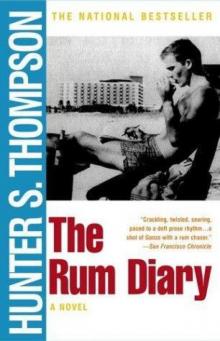 The Rum Diary
The Rum Diary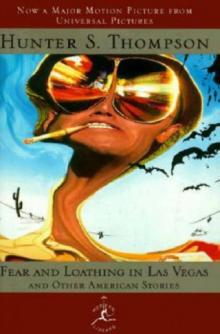 Fear and Loathing in Las Vegas and Other American Stories
Fear and Loathing in Las Vegas and Other American Stories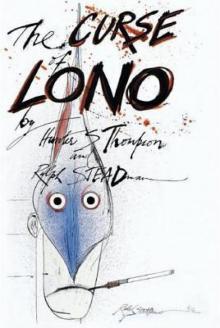 The Curse of Lono
The Curse of Lono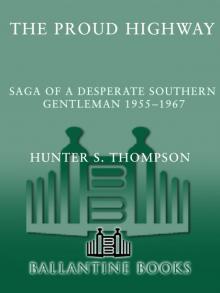 Proud Highway: Saga of a Desperate Southern Gentleman, 1955-1967
Proud Highway: Saga of a Desperate Southern Gentleman, 1955-1967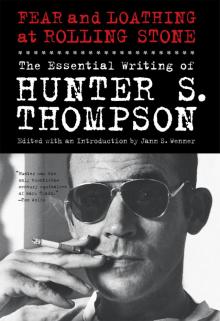 Fear and Loathing at Rolling Stone: The Essential Hunter S. Thompson
Fear and Loathing at Rolling Stone: The Essential Hunter S. Thompson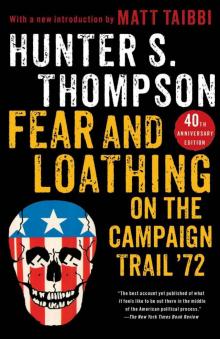 Fear and Loathing on the Campaign Trail '72
Fear and Loathing on the Campaign Trail '72 Hell's Angels: A Strange and Terrible Saga
Hell's Angels: A Strange and Terrible Saga The Great Shark Hunt: Strange Tales From a Strange Time
The Great Shark Hunt: Strange Tales From a Strange Time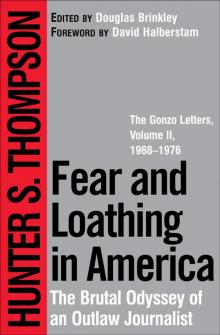 Fear and Loathing in America
Fear and Loathing in America Kingdom of Fear
Kingdom of Fear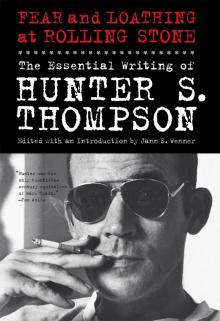 Fear and Loathing at Rolling Stone
Fear and Loathing at Rolling Stone Hell's Angels
Hell's Angels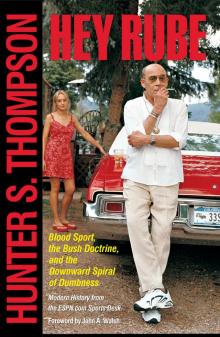 Hey Rube
Hey Rube Proud Highway
Proud Highway